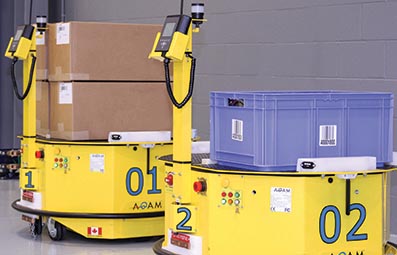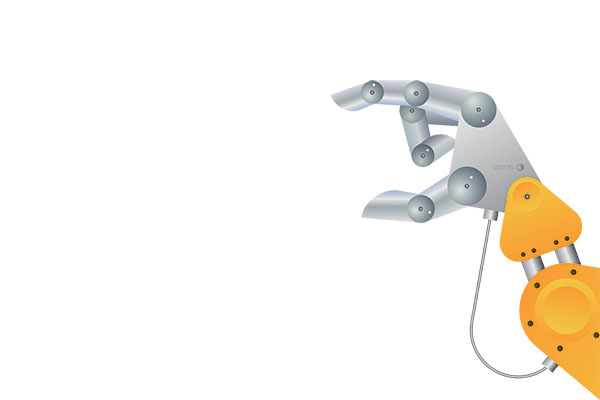Mobility & robotics in the warehouse: How far have we come?
A time when autonomous robots navigate the warehouse or DC unattended could be right around the corner. Is your company ready?
Visions of autonomous robots scooting around the warehouse floor, gathering data and performing tasks in a 24/7/365 environment—all with little or no human intervention—have been dancing around in the minds of designers and engineers for decades. Thanks to advances in technology, the high cost of labor and the ongoing push to eke more productivity out of the supply chain, robots are being called on to store, move, pick, put-away and sort inventory in more warehouses and DCs.
At least for now, it’s the early adopters that are jumping into the fray, namely due to budgetary and cultural challenges associated with the shift. However, much like we see with any disruptive innovation, as the technology improves and becomes less pricey—and as more people get used to the idea of robots in the warehouse—adoption rates are likely to grow exponentially.
Pretty far along the path
Intent on improving productivity, increasing order accuracy, reducing safety incidents and/or speeding up cycle times, a growing number of companies are exploring the notion of robots in the warehouse. And while automation-related job loss remains a top-of-mind issue for companies that are jumping into the robotics fray, few can argue the merits of infusing mobile, autonomous robots into an environment that would clearly benefit from automation.
“We’re not 100% there yet, but we’re pretty far along the path to having a turnkey robotic, item-level picking solution for the market,” says Mike Khodl, vice president of solution development at Dematic. Khodl says the company has made “rapid progress” over the last few years, namely when it comes to developing robots that can differentiate specific items, pick them and then place them into an order.
On a macro level, Khodl says the big advancements are taking place in two different areas: vision systems and robotic “hands.” For the former, he says costs have come down to a level where companies can achieve return on investment (ROI) from their robotic picking systems within a desirable timeframe. Those systems have also improved to the point where they can now “see” into a container and differentiate the items in it. As for the hands, Khodl says they now closely mimic that of a human, thus allowing for more accurate and precise “grabbing” and “reaching.”
Advances in sensor technology are also helping to move the needle for the robotics-enabled warehouse. “Mobility has existed in manufacturing for some time, but the detriment to using it in the warehouse is the ‘fixed path’ nature of these spaces,” explains Earl Wohlrab, robotics integration manager at Honeywell Intelligrated. “These fixed paths had to be clear in order for mobile robots to be able to do their jobs.”
Creating those paths isn’t easy in a warehouse or DC, where the physical environment is constantly changing, says Wohlrab. Complicating the issue even further is the need for guidance systems that relied on magnets and/or magnetic tape or localized global positioning systems (GPS). Innovations like simultaneous localization and mapping (SLAM)—or, building a localized map while at the same time localizing the robot within that map—are allowing mobile robots to “become completely autonomous in the work environment,” says Wohlrab, “rather than having to operate on a fixed path.”
Discovering robotics’ Holy Grail
Digging down into the technology and engineering that’s driving the modern-day robot, components like actuators, sensors, arms, hands and cameras (to name just a few) are all getting faster, more accurate and more cost-effective every year. At JBT Corp., for example, Mark Longacre, marketing manager for automated systems, says the company is putting more sophisticated actuators on its autonomous vehicles and then integrating the latter into mobile platforms that help companies solve problems.
But there’s still work to be done to get to the point where robots can physically replace a human, at least for some applications. “We talk a lot about putting robotic arms on our mobile platforms, and we sometimes refer to that as the Holy Grail,” says Longacre. “We’re definitely working toward the day when we can put a sophisticated robotic arm on a platform that allows it to move around, pick items and manipulate things. That’s the perfect, inevitable combination.”
The push toward that perfect combination is largely market-driven, according to Longacre, who has heard from numerous Fortune 50 companies that want this type of solution. “We’re definitely being pushed by large, multinational companies on this [front],” says Longacre. He adds that JBT has been working on small-scale projects in this arena, but acknowledges the business case could be difficult for users to make at this stage of the development process. “For now,” he adds, “the cost of this combination is a little more than can be justified.”
Moving from stationary to mobile
For the most part, functions like piece picking and palletizing are stationary solutions within the warehouse or DC. Are we moving to an era where we can combine mobility with these types of tasks? The suppliers we spoke to for this article all think so, although they also acknowledge that some stumbling blocks will need to be overcome to get there.
“Mobilizing those specific, stationary functions is probably still a little ways off,” says Wohlrab, who expects the next generation of robotics and/or software to pave more inroads in this specific area, where robots more effectively manage human tasks, functions and movements. “We’re headed in that direction, but we’re not there yet.”
Ultimately, Longacre says robots will be able to handle mixed-case picking in the DC. Getting there will require an extremely sophisticated camera system that allows the machine to see individual parts and then, using its human-like arm, pick those parts up and pack them. That vision will also have to incorporate an advanced end effector (i.e., the device at the end of a robotic arm) with vacuum grips that can “grab a wide variety of products,” says Longacre. “The final piece of the puzzle will be the mobile platform that transports the robot around the warehouse.”
That piece could be closer than many realize. Longacre says JBT has already produced a number of vehicles that are equipped with gantry-type robots (versus fixed-degree-of-freedom robots). One large manufacturer, for example, is using the machines to grip spools and then pull up to 36 of those spools onto an automatic guided vehicle (AGV). The AGV can then move to another area of the warehouse or plant to offload the items. “This is just one example of how we’re already seeing robotic arms integrated with vehicles,” says Longacre, “and being used to manage stationary/repetitive tasks.”
 Don Heelis, sales manager at Cimcorp, is also bullish on the robot’s ability to break through the barriers and start handling more distribution functions. He says Cimcorp has completed a number of installations with autonomous robots in a fleet environment, which is yet another step in the direction of the mobile robot that can navigate autonomously. In other words, the robot is programmed to get from Point A to Point B, but then largely left to its own devices on how to get there safely. “Eventually, it’ll find its way to its destination,” says Heelis. “That’s the key element of the autonomous mobile robot, and we’ve definitely made some inroads in this area.”
Don Heelis, sales manager at Cimcorp, is also bullish on the robot’s ability to break through the barriers and start handling more distribution functions. He says Cimcorp has completed a number of installations with autonomous robots in a fleet environment, which is yet another step in the direction of the mobile robot that can navigate autonomously. In other words, the robot is programmed to get from Point A to Point B, but then largely left to its own devices on how to get there safely. “Eventually, it’ll find its way to its destination,” says Heelis. “That’s the key element of the autonomous mobile robot, and we’ve definitely made some inroads in this area.”
Early adopters abound
As he looks around at how far mobility has come in the warehouse and the new innovations coming to market in 2016, Joe Zoghzoghy, mobile robotics manager at Bastian Solutions, says the right mix of supply and demand has finally arrived. On one side of the equation stand users that are demanding more automation in their DCs, and on the other side are the manufacturers that are answering the call and developing new solutions and equipment.
Somewhere in the middle are the humans who don’t want to see their jobs go away because robots can do them. This pushback doesn’t seem to be keeping companies from exploring their options. As evidenced by Amazon’s push to automate its own warehouse (and, purchase a robot-maker in order to make that happen), the drive to achieve higher productivity at a lower cost with the help of technology isn’t waning.
“Labor is an increasing cost, with seasonal labor being particularly difficult to manage and plan for,” says Longacre. “It causes a lot of problems for the companies and the employees, so a lot of firms are looking to technology and automation to help alleviate some of these pain points.”
Khodl concurs, and says the need for lower labor costs is one of the biggest drivers of warehouse automation and robotics right now. An e-commerce company that moves into an urban area to get closer to its customers could find itself in a tight spot on the employment side. “In some regions, it’s getting nearly impossible to find 500 to 600 people to work during peak seasonal periods,” says Khodl. “That’s where robotics can come into the picture.”
Going forward, Heelis expects more companies to come to this realization and explore their mobility options. “We’re at a threshold right now where a lot of companies recognize the potential and the value that robotics brings to their operations,” says Heelis, “but they’re still tentative because it’s not a technology that everyone is using. The people who are taking the step forward are the people on the leading edge; then the rest will follow.”
Companies mentioned in this article
• Bastian Solutions
• Cimcorp
• Dematic
• Intelligrated
• JBT Corp.

Article Topics
Equipment Report News & Resources
Radial stays ahead of the automation curve Wireless Mobility: Ready for the next leg up AGVs set new standards for inventory transportation Inside North Shore Care Supply: Bringing robots to receiving Bergen Logistics: Putting robots to work in a multi-tenant facility High-tech meets low-tech: Automate storage for pallet loads Tuggers, carts work together to increase productivity and ergonomics More Equipment ReportLatest in Materials Handling
NetLogistik partners with Vuzix subsidiary Moviynt to offer mobility solutions for warehouses Materials Handling Robotics: The new world of heterogeneous robotic integration Lucas Watson appointed CSO for Körber’s Parcel Logistics business in North America Hyster recognizes Dealers of Distinction for 2023 Carolina Handling names Joe Perkins as COO C-suite Interview with Keith Moore, CEO, AutoScheduler.AI: MODEX was a meeting place for innovation Walmart deploying autonomous lift trucks at four of its high-tech DCs More Materials HandlingAbout the Author
Subscribe to Materials Handling Magazine

Find out what the world's most innovative companies are doing to improve productivity in their plants and distribution centers.
Start your FREE subscription today.
April 2024 Modern Materials Handling

Latest Resources












